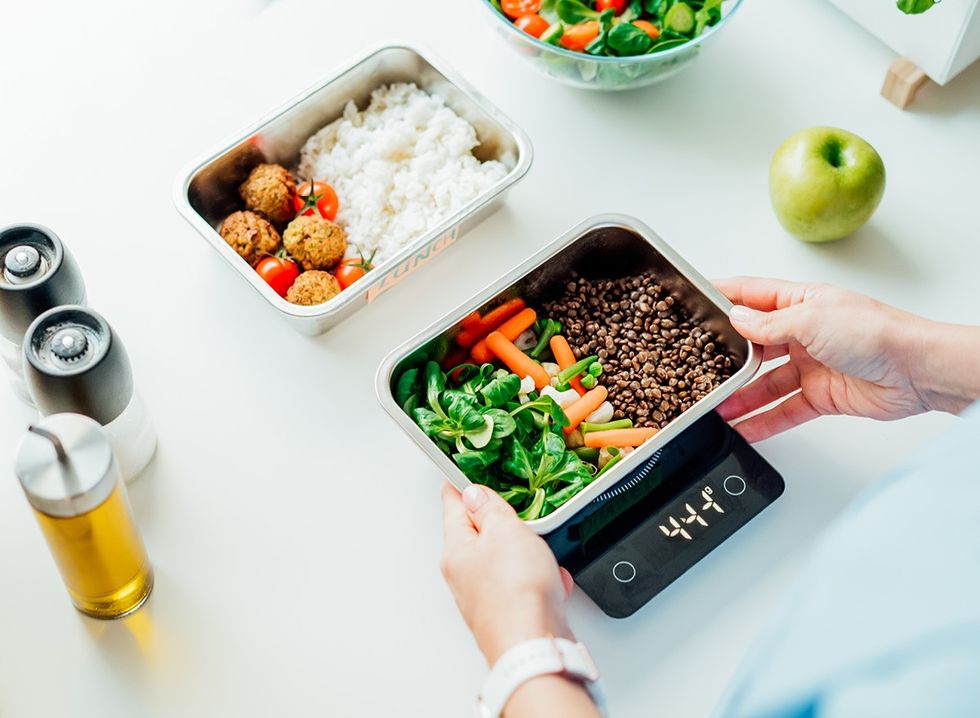Have you hit a weight loss plateau despite your best efforts? Nutrition coach Dani Marenburg has a solution: reverse dieting. This counterintuitive approach involves gradually increasing your caloric intake after prolonged dieting, allowing your body to recover from metabolic slowdown. Dani, a double-certified nutrition coach, has guided over 1,000 women through this process, helping them maintain their results and avoid regaining weight.
On her podcast Mindin’ My Macros, Dani explains how reverse dieting works by slowly adding calories back into your diet to reach your maintenance level. This not only helps rev up your metabolism but also supports muscle building when paired with strength training. Whether you've been in a calorie deficit for months or years, reverse dieting can help you break through plateaus and improve your overall health. Here are eight surprising tips to help you eat more and weigh less using reverse dieting principles.
Understanding Reverse Dieting
Dani explains on her podcast, "Reverse dieting is a term for the phase that comes after a deficit period, and we'll get into how to know if it's the right time to enter a reverse diet. But a reverse diet is a process of systematically and slowly adding calories back into your diet on a week-by-week basis or a biweekly basis, and we'll get into that, too, to build back up to your maintenance to maintain overall results from your deficit or to rebuild your metabolism after long periods of undereating."
She further elaborates, "So this is the phase that essentially you will slowly start to eat more to build up to your estimated maintenance. Now, I've already spilled a few reasons why a reverse diet is important to include after a deficit or after you've been undereating for an extended period of time. Number one is it can help to increase your metabolism and eat more without the weight gain or with limiting weight gain."
Who Should Consider a Reverse Diet?
According to Dani, there are three categories of individuals who could benefit from implementing a reverse diet:
- Post-Deficit Dieters: If you're concluding a planned calorie deficit, such as a cut or fat loss phase, a reverse diet can help you transition back to maintenance calories.
- Long-Term Low-Calorie Eaters: Those who have been on a low-calorie diet for more than four months may benefit from a reverse diet. This includes individuals who have been in a calorie deficit for years.
- Negative Biofeedback Experiencers: If you're experiencing negative biofeedback (physical signs from your body), potentially due to under-consuming calories or not meeting your body's nutritional needs, a reverse diet could be beneficial.
Dani explains that biofeedback refers to signals from your body, which she elaborates on later in the discussion. If you fall into any of these categories, a reverse diet might be a suitable approach to improve your overall health and fitness.
How to Implement a Reverse Diet
Dani outlines the reverse diet process, emphasizing a methodical approach to calorie increase:
- Focus on Carbs and Fats: The process involves systematically adding calories in the form of carbohydrates and fats.
- Avoid Online Macro Calculators: Dani strongly advises against using online macro calculators, as they don't account for crucial factors such as:
- Lifestyle habits
- Dieting history
- Medical history
- Preexisting conditions
- Gradual Calorie Increase:
- Aim to increase by about 100 calories per week or every other week
- Adjust based on your body's response
- Calorie Breakdown: Understanding macronutrient calorie content is crucial:
- Carbohydrates: 1 gram = 4 calories
- Protein: 1 gram = 4 calories
- Fat: 1 gram = 9 calories (more calorically dense)
By following this systematic approach, you can effectively implement a reverse diet tailored to your individual needs and body responses.
RELATED: I Tried Wegovy for a Year and Here's Why I'm Never Going Back
Track Your Progress
Dani gives us the lowdown on how to pace your reverse diet:
It's not one-size-fits-all. Some folks need to take it slow, while others can ramp up their calories pretty quick. So how do you know what's right for you? It's all about tuning into your body's signals.
Keep an eye on how your clothes are fitting. Are your jeans getting tighter or still comfy? Dani's a big fan of taking measurements too. She thinks it's one of the best ways to track your progress.
Here's a heads up: You might see the number on the scale go up during a reverse diet. But don't freak out! That doesn't automatically mean you're gaining fat. Your body's going through changes as you up your calories, and that can affect your weight in different ways.
The key is to pay attention to how your body's responding and adjust accordingly. That way, you can boost your calorie intake without packing on unwanted pounds
Determine the Length of Your Reverse Diet
Dani tackles this common question head-on. The short answer? It depends on you.
But don't worry, she gives us a handy way to ballpark it:
- Start with your current calorie intake
- Figure out your estimated maintenance calories
- Plan on adding about 100 calories per week
Then, do a bit of quick math. How many weeks would it take to get from where you are now to your maintenance level? That's your rough estimate.
For example, if you're eating 1500 calories now and your maintenance is 2000, you're looking at about 5 weeks (500 calorie difference / 100 calories per week).
RELATED: I Tried the Viral 12-3-30 Workout for 21 Days: Here's My Love-Hate Honest Review
Identifying Your Maintenance Level
So you've been reverse dieting for a while, but how do you know when to call it quits? Dani breaks it down for us:
It's not an exact science. There's no magic number that screams "You're at maintenance!" It's more of a trial and error thing.
Sure, you might have a rough estimate of what your maintenance calories should be. That's great - use it as a general guide. But don't get too hung up on hitting that exact number.
Instead, think of it as your "north star." It gives you a direction, but the real test is how your body responds.
You'll need to pay attention to things like:
- How your clothes fit
- Your energy levels
- Your workout performance
- How you feel overall
When you're consistently feeling good, your weight is stable, and you're not seeing any unwanted changes in your body composition, that's a good sign you've hit your sweet spot.
RELATED: I’m a Nutritionist, and This Protein-Packed Breakfast Helps Me Shed Pounds and Boost My Metabolism
What to Expect During a Reverse Diet
Dani gives us a reality check about reverse dieting:
First off, don't freak out if you see the scale moving around. It's totally normal, and here's why:
- Muscle Gains: If you're hitting the weights (which is a great idea), your body's gonna be all about building muscle now that you're feeding it more. More food means more building blocks for those muscles.
- Water Weight: Here's a fun fact - for every gram of carbs you eat, your body might hold onto up to four grams of water. So if you're upping your carbs, you might see a temporary bump in weight from water alone.
Understanding Weight Changes During a Reverse Diet
Dani's dishing out some real talk about what might happen during your reverse diet:
First off, you might've seen those Instagram posts where people are dropping pounds while reverse dieting. Is it possible? Yep, but it's not super common.
Here's the breakdown:
- The Lucky 25%: About a quarter of folks might actually lose some weight. This is more likely if you've been seriously undereating. Your body's been in survival mode, holding onto fat, and once you start eating more, it might relax and let go of some of that extra weight.
- The Steady 50%: Half of the people pretty much stay the same weight. No dramatic changes either way.
- The Slight Gain 25%: Another quarter might see a small uptick on the scale. But remember, this doesn't necessarily mean fat gain.
The takeaway? Everyone's body reacts differently. Don't expect miracles, but don't freak out if you see some changes either way.
The main goal of a reverse diet isn't weight loss - it's about getting your body back to a healthy place where it's getting all the fuel it needs. Any weight changes are just part of the process. And if you enjoyed this article, take advantage of these 15 Quick Ways to Lose Body Fat Percentage in a Week.















 Shutterstock
Shutterstock Shutterstock
Shutterstock Shutterstock
Shutterstock Shutterstock
Shutterstock Shutterstock
Shutterstock Shutterstock
Shutterstock Shutterstock
Shutterstock Shutterstock
Shutterstock


 Shutterstock
Shutterstock Shutterstock
Shutterstock Shutterstock
Shutterstock Shutterstock
Shutterstock

 I'm a Nutritionist and These 9 High-Protein Snacks Keep My Clients Full While Losing 50 Pounds
I'm a Nutritionist and These 9 High-Protein Snacks Keep My Clients Full While Losing 50 Pounds
 Shutterstock
Shutterstock 2. Processed FoodsShutterstock
2. Processed FoodsShutterstock Shutterstock
Shutterstock Shutterstock/Prostock-studio
Shutterstock/Prostock-studio Shutterstock
Shutterstock Pro TipsShutterstock
Pro TipsShutterstock Shutterstock
Shutterstock Shutterstock
Shutterstock Shutterstock
Shutterstock Shutterstock
Shutterstock Don’t Drink as Much AlcoholShutterstock
Don’t Drink as Much AlcoholShutterstock Most Women on GLP-1s Are Making a Few Common MistakesShutterstock
Most Women on GLP-1s Are Making a Few Common MistakesShutterstock Soda and Sugary DrinksShutterstock
Soda and Sugary DrinksShutterstock Shutterstock
Shutterstock Eat BreakfastShutterstock
Eat BreakfastShutterstock And Improve Insulin SensitivityShutterstock
And Improve Insulin SensitivityShutterstock Belly Flab Strip Tip: Sugar and Fat Calories Leave Its Mark on Your BodyShutterstock
Belly Flab Strip Tip: Sugar and Fat Calories Leave Its Mark on Your BodyShutterstock Shutterstock
Shutterstock The Drugs Mimic the GLP-1 Hormone Naturally Produced by the BodyShutterstock
The Drugs Mimic the GLP-1 Hormone Naturally Produced by the BodyShutterstock 3. Deep-Fried ItemsShutterstock
3. Deep-Fried ItemsShutterstock